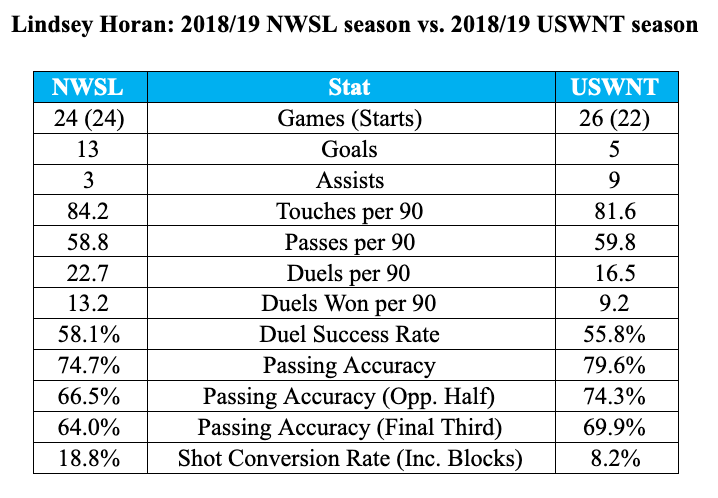Lindsey Horan might be the USWNT’s best player, but why has she gone unnoticed?
DEAUVILLE, France — For anyone who watched the National Women’s Soccer League last season, it wasn’t hard to pick up on who was going to be voted the league’s MVP.
Lindsey Horan was seemingly everywhere for the Portland Thorns – dishing line-breaking passes to set up her teammates, scoring goals, winning 50/50 balls, stamping out oncoming attacks, and just about everything else the Thorns did well.
But tune into a U.S. women’s national team game, and it’s not quite the same Horan. That’s not to say she isn’t influential, but she isn’t the heart of everything the U.S. does in the midfield in the same way.
Part of that is by design. Mark Parsons, the coach of the Portland Thorns, recognizing that Horan is good at everything, has put her in a position where she can do everything. A structure has been built around Horan so she is free to feel a game out and make an impact where she sees fit while the rest of the team ensures the fundamentals are handled.
“She is a player that has got it all,” Parsons says. “She can pass, she can shoot, she can dribble, she’s box-to-box, she’s everywhere, great short passer, long passer, medium passer, she can score with her feet, with her head. Because of all that, along with her strong mentality, you’ve got a player that can run midfield and run a game.”

For the U.S. women’s national team, including here in France where the Americans are vying to defend their World Cup title, Horan’s role is a bit more limited. She shares the central midfield with players who tend to take over games as well, like Julie Ertz, with her marauding disruptive abilities, and Rose Lavelle, with her creative flair.
“For Mark, it’s been a very easy thing to see,” Horan says. “He wants the ball to go through me on the field and he does give me this free role to go get on the ball whenever I want, to be wherever I want and to join the attack. He’s made that very clear to our team, which has been cool for me because it’s a different role than I’ve ever had.”
“Then you come here and it’s a bit different,” Horan continues, referring to the USWNT. “You’re playing on the national team and you can’t do everything absolutely the same.”
In that sense, Horan is more a cog in the USWNT midfield rather than the key influencer tying everything together. That is apparent when looking at data from Opta Sports, the official stats keeper of the NWSL, which also tracks the USWNT.
Horan hasn’t had much time in the NWSL this year due to the World Cup, but last year she led the league in a host of categories, including touches on the ball per 90 minutes, number of passes per-90, duels won per-90, and shot conversion. But for the USWNT, even despite the blowout games the team tends to have, Horan’s influence hasn’t been quite so outsized.

The numbers tell a story where Horan isn’t asked to be the star of the national team. She shoots the ball less and more often assists her teammates, who on the USWNT are better goal-scorers than the Thorns have. But the attack also isn’t flowing through her as much either.
Horan generally occupies the same space for both teams, although she is more mobile and roams more with the Thorns. But these charts from Opta show how different her ball movement is, and how differently each team moves the ball generally. These charts, which are snapshots of one Thorns games and one USWNT game, show every players’ aggregate position on the field (Horan is No. 10 for Portland and No. 9 for the USWNT) and the width of the bands represents the amount of passes between those players.


The USWNT likes to move the ball along the wide channels, whereas the Thorns are more likely to work the ball centrally, where Horan can be involved. That’s not necessarily a problem, but there is a lingering concern that the USWNT may be too one-dimensional in its attack. A player like Horan could prove useful.
Then again, just like the Thorns, which reached the NWSL Championship last season, the USWNT has figured out an approach that works. Ranked No. 1 in the world, the Americans have looked like the best team thus far in the World Cup and are favorites to lift the trophy again.
Still, Parsons believes that the USWNT would be best off getting the most out of Horan, who he says is the best midfielder in the world. He declines to critique what U.S. coach Jill Ellis is doing but says his own approach would be simple.
“What’s absolutely crucial for the U.S. women’s national team to be at their best is for Lindsey Horan to be at her best,” he says. “The view from (Portland) is: trying to get the best out of the best midfielder in the world who has been doing it every single week in the most competitive league makes sense to me.”
Caitlin Murray is a contributor to Yahoo Sports and her book about the U.S. women’s national team, The National Team: The Inside Story of the Women Who Changed Soccer, is out now. Follow her on Twitter @caitlinmurr.
More from Yahoo Sports:
